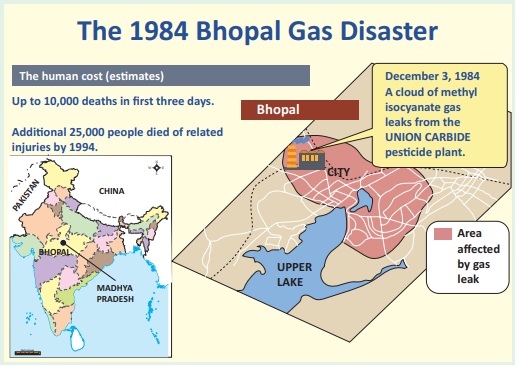Man made Disasters - Industrial Disasters | 12th Geography : Chapter 8 : Man Made Disasters Public Awareness For Disaster Risk Reduction
Chapter: 12th Geography : Chapter 8 : Man Made Disasters Public Awareness For Disaster Risk Reduction
Industrial Disasters
Industrial Disasters
Industrial hazards consist of four principle hazards. The hazards encountered are fire, explosion, toxic release and environmental damage. This is because industries engage in different processes involving a wide range of different raw materials, waste products and final products. Danger originates from technological or industrial accidents, dangerous procedures, infrastructure failures or certain human activities. It may cause the loss of life or injury, property damage, social and economic disruption or environmental degradation.
Fire: This is the most frequent hazard. Fire can also produce toxic fumes like Acrolein, Carbon monoxide and Cyanides. Physical structures can be damaged either by the intensity of the heat or combustion. It may also have an effect on essential services like power and instrumentation.
Explosion: Explosions is the result of a shock wave. This overpressure can kill people but usually the indirect effects of collapsing buildings, breaking of glasses and falling of debris causes far more loss of life and severe injuries. There are different types of explosions which include gas explosions and dust explosions. Gas explosions occur when a flammable gas mixes with air. Dust explosions occur when flammable solids, especially metals, in the form of fine powders are intensively mixed with air and ignited.
Chemical release: Sudden release of toxic vapours has the potential to cause death and severe injuries several kilometres from the release point. They are carried by water and air. Their release into public sewage systems, rivers, canals and other water courses, either directly or through contaminated water used in fire fighting can result in serious threat to public. The number of casualties depends on the weather conditions, population density in the path of the cloud and the effectiveness of the emergency arrangements.
Environmental Damage: Release of other substances, not directly toxic to humans can cause major pollution problems. It is becoming increasingly recognized that damage to natural resources such as plant and animal life can have serious long term consequences. E.g. destruction of trees is increasing the effect of global warming and extinction of animals are severely disrupting food webs and causing an increase in pests.
Means of reducing the industrial hazards
Process of Safety Management: Reliability assessment of process equipment, incorporating safety tips, scrubbing system, etc, should be done before effecting major process changes.
Safety Audits: Periodical assessment of safety procedures, performance of safety systems and gadgets along with follow up measures should be carried out.
Emergency Planning: A comprehensive risk analysis indicating the impact of consequences and practiced emergency procedures should be done. This can be done by communities as well as national or regional corporation authorities.
Training: Proper training of employees and protective services should be done.

Related Topics